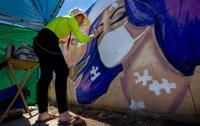PHOENIX — Arizona schools will divide up $270 million in federal cash to help them get started when classes resume.
The plan announced Wednesday by Gov. Doug Ducey includes $200 million from the Coronavirus Aid, Relief and Economic Security Act to protect schools against budget shortfalls due to anticipated enrollment declines.
In essence, it guarantees that schools will have at least 98% of the state aid they were getting this past school year.
That is crucial as state aid is based on the number of students in attendance. And a survey done last month by the political consulting firm HighGround found 20% of adults with children in school said they would not send them back next year given fears of COVID-19.
And if 20% of a district’s students choose not to start when the doors open, that would normally translate to a 20% drop in aid. With basic aid at $5,500 per student, that would have taken a real bite out of the money schools get.
The plan also contemplates that schools will provide more instruction online than in traditional years. Part of the $200 million is earmarked as funding for remote learning.
Potentially more significant, the state will provide full funding even for students who are not sitting in a classroom all day, five days a week.
This is particularly crucial for districts that want to have more flexible schedules to reduce the number of students in a classroom at any one time, said Chuck Essigs, lobbyist for the Arizona Association of School Business Officials.
For example, he said Eloy schools are looking at a plan where half the students would attend in the morning and then be sent home with assignments for the afternoon. The other half would have homework in the morning and go to class for the rest of the day.
Without this flexibility, Essigs said, districts would get funded only on a half-time basis for each student.
There is a catch, though: In order to be eligible, schools must be open to all students five days a week.
That does not preclude a district from deciding that it wants its students going on alternate days to limit the number in any classroom. But it does mean that if a parent has nowhere else to send a child, the school must agree to take him or her every day — not just the days the student otherwise would attend — even if it means that child stays in the library.
“This plan provides schools with the flexibility to ensure Arizona students continue to receive a quality education, whether through distance learning or in the classroom,” Ducey said in a prepared statement. He said it “provides parents with options that work best for their families.”
The guaranteed funding and flexibility are the most crucial for schools, said Chris Kotterman, lobbyist for the Arizona School Boards Association. The only question, he said, is whether there’s enough money in the plan.
“I hope that that $200 million holds up,” he said.
On top of the $200 million, the plan allocates another $69 million that Ducey received from the CARES program. The largest share of that, $40 million, is earmarked for bridging the “digital divide.”
The closure of schools earlier this year brought into focus the fact that many students lack access to the internet at home.
Much of the $40 million will go to expanding access to broadband in rural Arizona, with a new connection to Flagstaff by the end of next year and plans for more conduit and fiber along Interstate 19 from Tucson to Nogales.
What’s not included, however, is any money to purchase computers or high-speed modems for individual students. But aides to the governor said schools may have access to other funds, including $27 million that state schools chief Kathy Hoffman has in discretionary dollars.
Another $20 million is set aside to help students catch up on what many missed after in-person instruction disappeared when the governor and Hoffman shuttered schools in the middle of March due to the pandemic.
These funds, however, would be given out in grants, with eligibility based on various indicators of academic need and accessibility to resources. Traditional school districts and charter operations would apply for one-time funding.
Ducey also is putting $6 million into the Arizona Teachers Academy he got lawmakers to create several years ago in a bid to convince more college students to go into the classroom by paying for their college tuition.
The COVID-19 outbreak has only increased the number of older teachers leaving the profession, worsening what the governor’s office is calling the “Gray Wave” or “Silver Tsunami.”
The $6 million in additional dollars, on top of $15 million already in the state budget for the academy, should provide enough to pay the tuition of another approximately 1,200 college students.
One thing not in the plan is funding to cover what are expected to be higher transportation costs.
Essigs said schools won’t be able to fill buses with students, as had been done before, and yet still maintain the required social distancing. That, he said, will result in more trips, meaning more gasoline and, eventually, more wear-and-tear on buses.
Aides to Ducey said schools have direct access to other money, including funds from the Federal Emergency Management Agency, that could be directed to cover some of those costs.
Overall, Essigs said, he sees the plan as a positive development. “At least it’s better than what it was before,” he said.
Other elements include:
- $1 million for “school innovation microgrants” for innovative programs.
- $1 million for new vehicles for the Arizona Schools for the Deaf and the Blind.
- $700,00 to expand the Beat the Odds program to help train school leaders, particularly in rural and underperforming schools.
- $500,000 for the Teach for America program to provide tutoring to children defined as the most in need.
Also, school districts will be exempt from normal procurement rules — meaning going out and soliciting bids — for cleaning supplies and any other personal protective equipment needed.
Photos for May 29: Tucson gets by during Coronavirus Pandemic
Tucson gets by during coronavirus pandemic
Updated
The iconic Casa Molina bull and matador statue both sport masks on the first full week of the loosening of COVID19 restrictions, May 23, 2020, Tucson, Ariz. The bull previously had a mask on the testicles.
Tucson gets by during coronavirus pandemic
Updated
Michelle Leon Cordova, right, mother, and her son Sahuarita High School senior Lino Cordova, whom is fighting cancer, wave at staff members from Diamonds Children Center, friends and the Marana Police Department during a car parade, celebrating Lino's graduation, outside of his home on May 13, 2020 in Sahuarita, Ariz. Cordova stood on the sidewalk while the team from Diamond Children Center, friends and the Marana police department gave Cordova a graduation gar parade. Cordova was given a gift basket with his favorite snacks, gift cards as well as other items he enjoys. The car parade, also, celebrated another graduating senior fighting cancer from Empire High School, Noah Nieto. Nieto, also, received a gift basket with snacks, gift cards and other items Lino enjoys.
Tucson gets by during coronavirus pandemic
Updated
Michelle Leon Cordova, right, mother, brings celebration balloons to a car after staff members from Diamonds Children Center, friends and the Marana Police Department celebrate Sahuarita High School senior Lino Cordova, whom is fighting cancer, graduation with a car parade outside of his home on May 13, 2020 in Sahuarita, Ariz. Cordova stood on the sidewalk while the team from Diamond Children Center, friends and the Marana police department gave Cordova a graduation gar parade. Cordova was given a gift basket with his favorite snacks, gift cards as well as other items he enjoys. The car parade, also, celebrated another graduating senior fighting cancer from Empire High School, Noah Nieto. Nieto, also, received a gift basket with snacks, gift cards and other items Lino enjoys.
Tucson gets by during coronavirus pandemic
Updated
Personnel from Tucson Medical Center line the heliport to watch A-10's from Davis-Monthan Air Force Base's 355th Wing and F-16's from the Arizona Air National Guard's 162nd Wing make a pass over the facility, one leg of an area wide community flyover, May 14, 2020, Tucson, Ariz.
Tucson gets by during coronavirus pandemic
Updated
Nancy Celix-Campos, right, a respitory therapist at Tucson Medical Center, watches the military flyover with her daughters, Giana, 12, and Jazmyn, 8, from Sentinel Peak on May 14, 2020. Two F-16 Fighting Falcons from Arizona Air National GuardÕs 162nd Wing and two A-10 Thunderbolt II's from the 355th Wing, assigned to Davis-Monthan Air Force Base, fly over Tucson area hospitals to honor healthcare personnel and first responders as they are some of the frontline workers dealing with the coronavirus disease (COVID-19) head on. "It's been an exhausting two to three months," says Campos, "it's pretty cool, I like how they're going by each hospital."
Tucson gets by during coronavirus pandemic
Updated
Two F-16 Fighting Falcons from Arizona Air National Guard’s 162nd Wing and two A-10 Thunderbolt II's from the 355th Wing, assigned to Davis-Monthan Air Force Base, fly over Northwest Medical Center north of Tucson on May 14, 2020.
Tucson gets by during coronavirus pandemic
Updated
A letter carrier portrait on the Ok Market building, located in the Armory Park neighborhood, is adorned with a face mask on May 18, 2020.
Tucson gets by during coronavirus pandemic
Updated
Rosemary Garcia waits for a family member outside of a store at Park Place Mall, 5870 E. Broadway Blvd., in Tucson, Ariz. on May 19, 2020. Malls reopened today under CDC guidelines and Gov. Ducey's new rules for businesses due to the Coronavirus pandemic. Park Place Mall has signs throughout the mall reminding customers to keep a six feet distance as well as hand sanitizer stations near each entrance. About half of the tables in the food court have been removed to allow for social distances as well as less than half of the stores have opened with new guidelines. Of the stores open, only 10 customers are allowed to shop in each store at a time.
Tucson gets by during coronavirus pandemic
Updated
Pat Schlote steams clothing before it is put on the sales floor at the Golden Goose Thrift Shop in Catalina, Ariz., on May 21, 2020.
Tucson gets by during coronavirus pandemic
Updated
Ada Contreras, teaching assistant, looks through containers while reorganizing toys at Herencia Guadalupana Lab School, 6740 S. in Tucson, Ariz. on May 21, 2020. As Child care centers begin to re-open when they are ready, Herencia Guadalupana Lab School is reorganizing and cleaning everything in the facility before re-opening on June 2. To allow for social distancing and decrease the amount of items children touch, Herencia Guadalupana Lab School has sheds where items will go as well as placing items in containers organized by category.
Tucson gets by during coronavirus pandemic
Updated
Jen Martinez, right, softball coach, teaches Skylar Reilly about hitting during a session at Centerfield Baseball Academy, 5120 S. Julian Dr., in Tucson, Ariz. on May 21, 2020. After re-opening on Monday, Centerfield Baseball Academy has implemented new policies in response to the Coronavirus Pandemic such as wearing masks, cleaning, signage, hand sanitizer and limiting the amount of people inside the facility.
Tucson gets by during coronavirus pandemic
Updated
Karl Bosma, left, and George Cantua, with facilities and maintenance, lay down stickers to mark six-foot separation distance around one of the baggage carousels, part of the efforts at Tucson International Airport to work within the restrictions of COVID19, May 22, 2020, Tucson, Ariz.
Tucson gets by during coronavirus pandemic
Updated
A lone passenger waits for a flight near one of the shuttered restaurants in the B Gates before Memorial Day at Tucson International Airport on May 22, 2020.
Tucson gets by during coronavirus pandemic
Updated
Drew Cooper on the stage in the St. Philip's Plaza courtyard, May 22, 2020, Tucson, Ariz., where live music is back on the schedule.
Tucson gets by during coronavirus pandemic
Updated
Many people visit Tumamoc Hill during the first day of Tumamoc's re-opening in Tucson, Ariz. on May 25, 2020. After being closed due to the Coronavirus pandemic, Tumamoc Hill re-opened with some modifications. There are hand sanitizer stations throughout the hike to the top as well as arrows, spaced 10-ft apart, lined up and down the hill. Some runners, hikers and walkers are also wearing masks during their hike. "The steps we are taking aim to provide our community with needed exercise, connection to our beautiful desert and a sense of comfort in such a trying time, while balancing the fact that gathering as a community endangers each of us and our loved ones. This is an unprecedented challenge that we are taking extremely seriously," said Benjamin T. Wilder, director of Tumamoc Hill. Visitors are also asked to limit their group to three people and to not touch the gate at the top of the hill- a tradition for some who make it to the top. "This is a time when we need to establish new traditions and adapt in a creative manner that embraces empathy, unity, care and patience," Wilder said.
Tucson gets by during coronavirus pandemic
Updated
Pen Macias, artist, works on part 2 of a mural for a client on E. Broadway Rd., between S. Columbus Blvd. and S. Alvernon Way, in Tucson, Ariz. on May 25, 2020. Macias, known as The Desert Pen, has been working on her clients mural for the past three months. "It's the one thing I love, I have a passion for and the only thing I could be happy doing," said Macias. The mural represents her client, a single mother of four who works in the health care field. One half of the mural is dedicated to the connection between mothers and their children. The other half is dedicated to the connection between nurses and patients. The client wanted some positivity in the mural to show how nurses give a piece of themselves to their patients hence the puzzle pieces in the nurse and the patients, said Macias.
Tucson gets by during coronavirus pandemic
Updated
Christina Cortinas, posing at her home, May 28, 2020, Tucson, Ariz., with a photo of her and her mother, Catherine Rodriguez, in San Diego, 1991. Rodriguez is currently in assisted living and fighting COVID19. Cortinas hasn't seen her mother in months, the longest such span in her life.
Tucson gets by during coronavirus pandemic
Updated
Ruben Lopez looks through handouts while attending a Eviction Resource Fair with his family outside the Pima County Justice Court.





